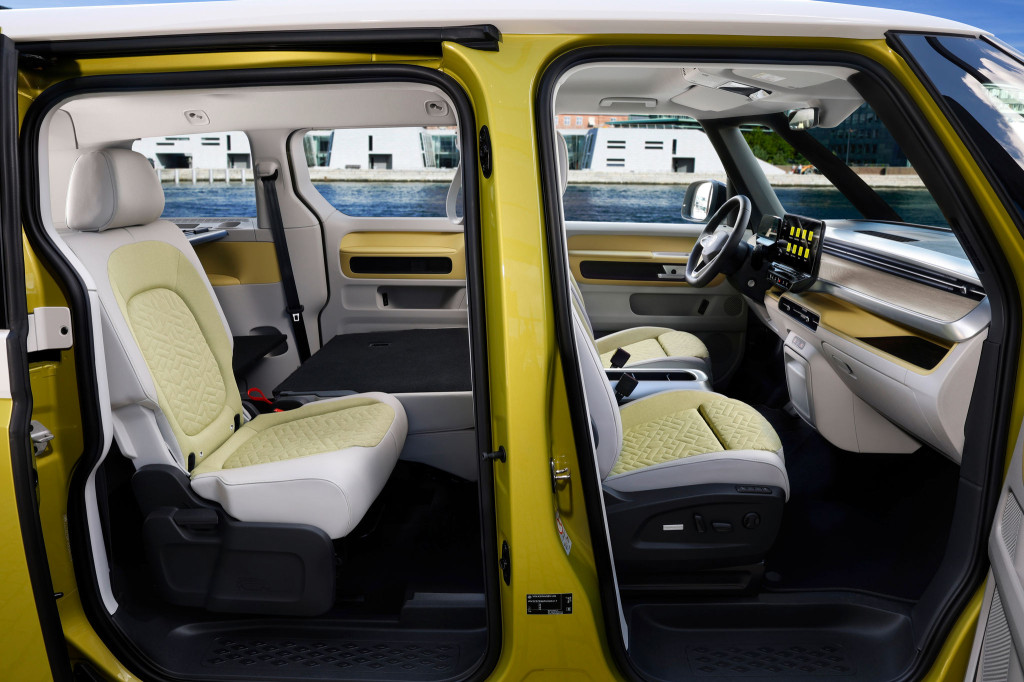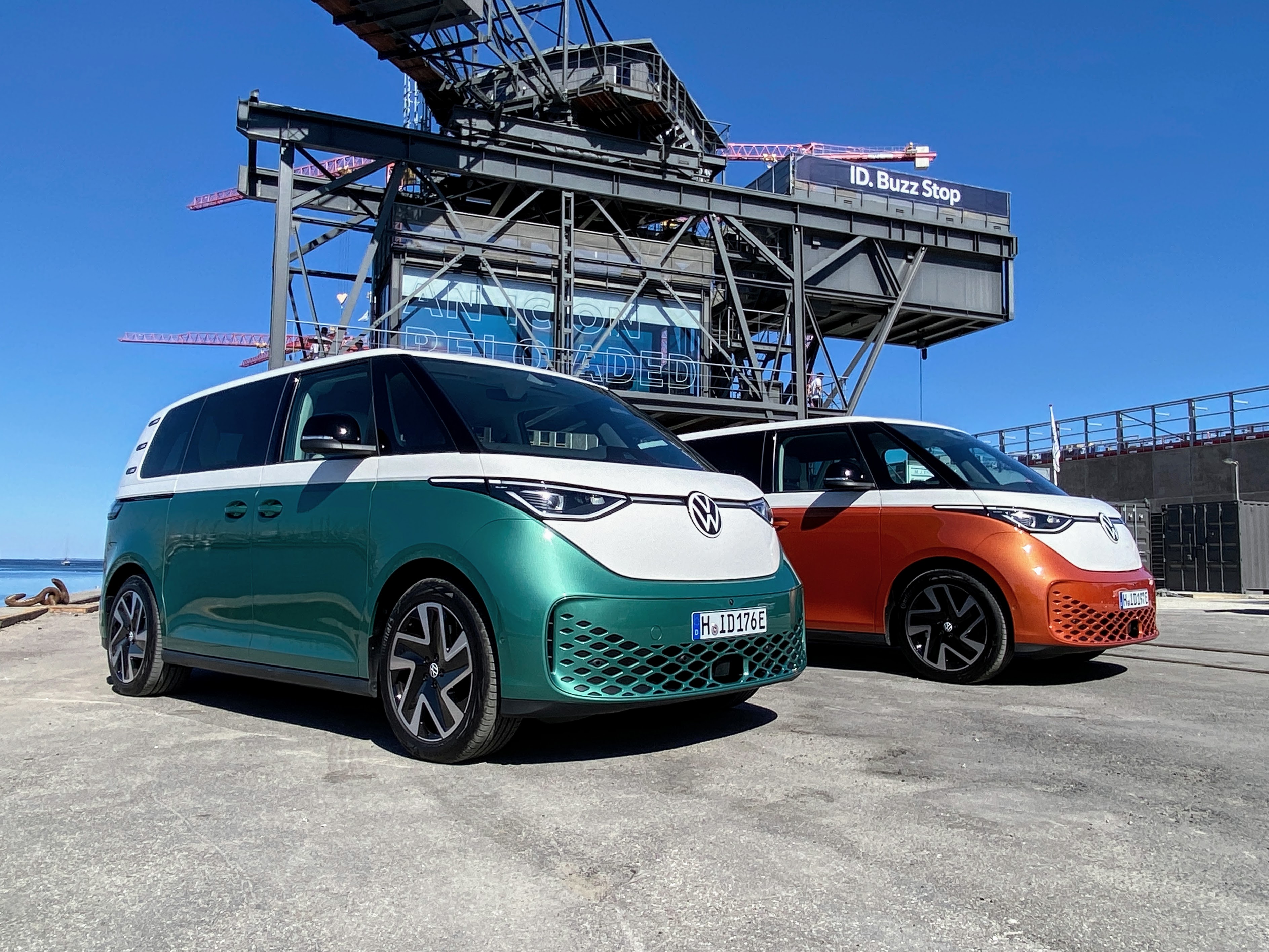In Sweden, unless alcohol is involved, conversation with strangers can be suspect.
And yet head-turning doesn’t even start to describe the kind of attention I experienced in a first test drive review through some coastal towns of its Skåne county in Volkswagen’s ID.Buzz electric van.
It was more than I recall seeing in a supercar, but in all fairness the vehicle wasn’t moving nearly as rapidly. Over and over, rubberneckers pulled alongside my driving partner and I on the road, and when parked people lingered nearby and approached with questions. One man stepped into the camera shot when we parked for a photo op. And a speedy-looking road biker actually flagged us down in the middle of the road—not with any kind of emergency, but to ask about the van in a language not his own.
I can only imagine what the response would be in California, where a production version of the ID.Buzz remains nearly two years away. That version will arrive in extended-wheelbase form, and potentially with a bigger battery pack than the 82-kwh pack in our test vehicle. Nostalgia triggers for the Type 2 Microbus run deep in California, and the van’s debut will mark roughly seven years since VW first revealed the ID.Buzz at the 2017 Detroit auto show and then the same year let us take the wheel in a driving concept.

Volkswagen ID.Buzz (Euro spec)
At 185.5 inches long, the Euro-spec ID.Buzz is about the length of what would be considered a compact crossover in the U.S., as vehicle size creeps upward. The wheelbase is 117.7 inches for the current ID.Buzz model, while the long-wheelbase U.S. version will stretch 10.6 inches longer—amounting to an expected 118.3 inches.
Vanning past the New Beetle
After spending the rest of the afternoon with the Buzz, my buzz didn’t fade. VW absolutely nailed the exterior design, while learning from the mistakes of the New Beetle inside. This isn’t a vehicle that will feel out of vogue in a few years.
This time, VW has kept the retro cues outside and hasn’t gone so far above and beyond with them inside. There’s no vase inside, and no other overt nods to the flower power days. The ID.Buzz is just a very practical, comfortable modern electric van inside, and the biggest concession to the retro snout involves the angled front quarter windows that, from inside, essentially break the A-pillar into two.
Even that’s a pragmatic choice, though. The wrapped windscreen, smooth snout, and smooth underbody help allow a low 0.29 coefficient of drag for the passenger version.

Volkswagen ID.Buzz (Euro spec)
The reason VW didn’t go so New Beetle with the ID.Buzz likely comes down to nostalgia. Those who once owned the original air-cooled Buses when they were new or nearly new are into retirement age by now. The target customers are likely those who feel a hint of nostalgia because their family owned one when they were kids—or there’s one in the family album. What’s inside doesn’t need to push those buttons.
It’s a fine, modern, two-row van inside. You sit upright, with a great view outward and forward, even despite that front pillar arrangement. The only thing I noted when parking was that it was hard to tell where the front corners of the vehicle are.
Nothing buggy inside
The interface will feel familiar to anyone who’s been in the current Volkswagen ID.4—and a growing group of the latest VW vehicles. The driver gets a freestanding 5.3-inch display, while touchscreens are either 10.0 or 12.0 inches. Two communications packages are distinguished mainly by whether or not they include navigation. There are up to eight USB-C ports, including two just to the right of the steering wheel and one built into the passenger door. Most of these are next to storage trays and they can deliver 45 watts—enough to charge a laptop or tablet at a rapid clip, and VW will offer an AC outlet as an option. Stay tuned for how many amps that means for the U.S., but it’s powered by the 12-volt accessory circuit.
Spotify and Apple Music “from now can thus be used in the ID.Buzz even without a linked up smart phone,” according to Volkswagen, although that’s among the many features that might be market-dependent. Vehicles at the test drive were running a quick-reacting and bug-free software version 3.2 that’s just starting to arrive in 2023 ID.4 models and should be available over the air soon.

Volkswagen ID.Buzz (Euro spec)

Volkswagen ID.Buzz (Euro spec)

Volkswagen ID.Buzz (Euro spec)
The second row is a bench seat good for three, split 60/40 with reclining backrests, and each section can slide 5.9 inches fore and aft. The Pro version we tested also has power-sliding doors on each side. Just mind that the second row doesn’t have anywhere to go if you have a long, flat item. The battery’s down there.
Loaded to the top edges of the rear seatbacks, there’s a whopping 39.6 cubic feet of cargo space, and if you fold the second-row seatbacks forward that grows to 77.9 cubic feet—note that neither are the typical U.S. SAE measurements. Seating will likely change in U.S. form anyway.
Howzz id drive?
The ID.Buzz borrows extensively from Volkswagen’s existing MQB platform and the ID.4 crossover. It rides on MacPherson struts in front, with a multi-link arrangement in back, and while it has disc brakes in front it might be the most expensive passenger vehicle on the market with rear drums.
For now, in its Euro-spec ID.Buzz Pro launch form, the Buzz isn’t all that quick or particularly engaging to drive. Instead, it aims for a smooth ride with a quiet, tightly assembled interior. There’s loads of roll if you pitch it hard into a roundabout, but with the battery set low and surprising amounts of grip, its capabilities are far beyond that lean. Hard braking also doesn’t produce the sort of nosedive you get in other vans.

Volkswagen ID.Buzz (Euro spec)
The ID.Buzz directly borrows its single permanent-magnet electric motor from the ID.4, and at the rear wheels it delivers 201 hp and 228 lb-ft of torque. VW says that the Buzz will get to 62 mph in about 10 seconds (quite leisurely), and in European spec the ID.Buzz is limited to a top speed of 90 mph.
That said, we got up to around 80 mph and found that wind noise remains well-hushed, perhaps even better so than in the ID.4.
VW all but confirmed that an all-wheel-drive version is on the way, pointing out how the company left the same package space open around the front axle. In AWD form, the ID.4 makes 295 hp and 339 lb-ft of torque. The ID.Buzz sure could use that extra power.
Just as in the ID.4, the ID.Buzz essentially offers two levels of regenerative braking. If you drive in “D,” the ID.Buzz will decelerate very lightly, unless you’re already following someone closely. Click over to “B” and the ID.Buzz decelerates more abruptly when you lift off the accelerator, pulling up to 0.3 g, which is typical for EVs with one-pedal driving capability.

Volkswagen ID.Buzz (Euro spec)
An 82-kwh lithium-ion battery pack provides 77 kwh of usable capacity and will deliver more than 250 miles of range if you go by more generous WLTP standards. The ID.Buzz takes advantage of stepped-up 170-kw peak DC fast-charging power that allows a 5% to 80% charge in 30 minutes.
Different Buzz, same design on the way for the U.S.
VW plans to offer the passenger-oriented ID.Buzz Pro—not to be confused with the professional version, the ID.Buzz Cargo—in a great array of builds and choices, spanning 18-, 19-, 20-, and 21-inch wheels. The one we spent the day in rode on 20-inch alloys with Continental EcoContact self-sealing tires.
In Europe, VW is offering a version of its Travel Assist driver-assist system that utilizes crowdsourced lane-position “swarm data” from other Volkswagens. That swarm data allows automated lane changes at speeds of 90 km/h (56 mph). A new Park Assist Pro can remember five different real-world parking maneuvers, automatically offering assisted parking if it recognizes one of them.

Volkswagen ID.Buzz (Euro spec)
Color is part of what makes the ID.Buzz pop, and it’s offered in a palette of hues far more adventurous than anything we’ve seen from VW since the New Beetle. In Europe, the possibilities include Candy White, pearlescent Deep Black, five colorful metallic finishes, and four two-tone finishes—Lime Yellow, Starlight Blue, Energetic Orange, and Bay Leaf Green. On each two-tone model, the upper roof, upper rear portion, and V-shaped hood area are Candy White, amounting to an homage to the original Bus.
If the interior ever feels too austere, ambient light available in passenger versions will deliver up to 30 colors.
It’s great. Now about that wait…
VW has managed to create a design that’s almost entirely in line—in profile and details—with the concept vehicle that charmed people so much five years ago. But it made some smart choices

Volkswagen ID.Buzz (Euro spec)
Don’t linger long on features and trim levels for Europe because we’ll get a longer van, possibly with different materials, and likely never see this form of the ID.Buzz. That said, the ID.Buzz is not cheap. In VW’s home country, it starts at the equivalent of about $54,000 for the ID.Buzz Cargo and $64,000 for the five-seat, passenger-oriented ID.Buzz Pro. Don’t expect U.S. versions to land much below $70,000 when they arrive in two years—likely in volumes far too limited for demand.
We’ll just have to hope you can wait.
_____________________________
VW paid for travel and lodging for Motor Authority to wow the Danish and Swedish locals and bring you this test drive review.

ivermectin stromectol – tegretol order carbamazepine 200mg drug
where to buy isotretinoin without a prescription – order linezolid 600 mg pill zyvox over the counter
buy amoxil sale – valsartan over the counter combivent 100mcg over the counter
buy azithromycin online cheap – tinidazole where to buy order generic nebivolol
gabapentin 600mg canada – gabapentin 100mg cheap order sporanox generic
clavulanate tablet – cymbalta 40mg ca order cymbalta sale
purchase amoxiclav online – nizoral brand order cymbalta 20mg sale
buy semaglutide 14 mg for sale – cost cyproheptadine 4mg buy periactin 4mg online
brand zanaflex – buy generic hydroxychloroquine 400mg buy generic microzide
buy tadalafil 5mg pill – cheapest viagra viagra generic
buy viagra online cheap – cialis 5mg pills cialis 20mg for sale
how to buy cenforce – buy generic cenforce for sale buy cheap glycomet
order prilosec generic – order metoprolol pill buy generic tenormin 100mg
cost methylprednisolone – aristocort 4mg generic order triamcinolone 10mg sale
desloratadine 5mg for sale – buy generic loratadine 10mg order priligy 60mg
misoprostol usa – diltiazem 180mg for sale buy diltiazem cheap
acyclovir 400mg brand – oral crestor 20mg order rosuvastatin 10mg online
domperidone buy online – buy cyclobenzaprine 15mg online cheap flexeril for sale
domperidone pill – purchase motilium pills order flexeril 15mg
buy inderal 20mg pill – buy generic plavix buy methotrexate pills for sale
cheap warfarin 5mg – buy cheap hyzaar hyzaar price
buy levofloxacin 250mg generic – zantac 150mg over the counter order ranitidine sale
esomeprazole pills – buy imitrex pills imitrex canada
buy mobic 7.5mg for sale – order celebrex online order generic tamsulosin
zofran 4mg price – aldactone 25mg oral cheap simvastatin 10mg
valtrex 1000mg pills – buy valtrex for sale diflucan 100mg pills
order modafinil pills buy generic modafinil 100mg provigil 200mg canada order modafinil online cheap order provigil buy provigil 200mg for sale provigil canada